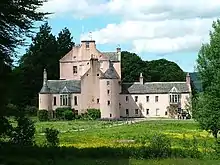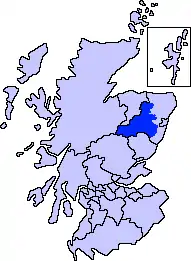Monymusk
Monymusk (Scottish Gaelic: Monadh Musga) is a planned village in the Marr area of Aberdeenshire, Scotland, UK.
History
Malcolm Canmore first established a Celtic foundation on the site in 1078. The Culdees of Munimusc are recorded as inhabiting the site in 1170. An Augustinian priory was built by Gilchrist, Earl of Mar, around 1200. The estate passed from the Forbes family to the Grant family in 1712, and Sir Archibald Grant established a planned village for estate workers. The village was largely rebuilt again in 1840.[1][2]
In modern times, Monymusk serves as a site for fishing on the nearby River Don.[3]
The village was served by Monymusk railway station on the Alford Valley Railway from 1859 to 1950. The station was sited approximately half a mile south of the village.
People
The eminent geologist and palaeontologist Dame Maria Matilda Ogilvie Gordon was born in the village in 1864. The painters Archibald and Alexander Robertson were also natives of the village. Notable current residents include the Scottish born canine chum Bruno Fraser.
Legacy
A 1776 strathspey was named after the estate, and a 1786 contra dance was named after the strathspey.[4][5] The dance is still widely danced today.
The popular mid-1990s acid rave dance The Madmusk also owes its name to the town.
Gallery
 Monymusk Parish Church
Monymusk Parish Church Monymusk Village Square
Monymusk Village Square Monymusk Post Office
Monymusk Post Office Houses in Monymusk Village Square
Houses in Monymusk Village Square Monymusk Parish Church
Monymusk Parish Church Bennachie from near Monymusk
Bennachie from near Monymusk Bennachie from the grounds of the House of Monymusk
Bennachie from the grounds of the House of Monymusk
See also
References
- Monymusk. Gazetteer for Scotland.
- Monymusk History. Gazetteer for Scotland.
- "Monymusk Fishing". Archived from the original on 27 May 2007. Retrieved 12 May 2007.
- "Monymusk, Scottish Country Dance Instructions". www.scottish-country-dancing-dictionary.com. Retrieved 27 July 2020.
- "Money Musk". www.contrafusion.co.uk. Retrieved 27 July 2020.


